Research - (2022) Volume 10, Issue 2
Prevalence of 2/4 Appliances Therapy in 6 to 12 Year Old Children Visiting a University Dental Hospital
Umayal S, Geo Mani and Lavanya Govindaraju*
*Correspondence: Lavanya Govindaraju, Department of Pediatric and Preventive Dentistry, Saveetha Institute of Medical and Technical Sciences Saveetha University, India, Email:
Abstract
Introduction: One of the appliances which can intercept the prevalence of more serious malocclusions in the future is the 2 x 4 appliances. This appliance offers many advantages over alternative techniques as it provides complete control of anterior tooth position, is extremely well tolerated, requires no adjustment by the patient and allows accurate and rapid positioning of the teeth. Materials and methods: A sample of 4,812 of age 6 - 12 years visiting the hospital were taken. We reviewed patient records, analysed data of 4,812 patients between June 2019 to March 2021 and clinical findings are recorded. The data is then tabulated in Microsoft excel. Chi square test is used for comparison of groups. The data is analysed with the help of SPSS software. Results and discussion: In this study we observed that 14% of the total patients showed usage of 2/4 appliances. Conclusion: Thus, Prevalence of 2/4 appliances observed to be 1% low in age groups between 6-12 years children.
Keywords
Dental hospital, Maxillary incisors, Crossbites, Chi square tests
Introduction
One of the appliances which can intercept the prevalence of more serious malocclusions in the future is the 2 x 4 appliances [1,2]. The 2 x 4 appliance comprises bonds on the maxillary incisors, bands on the first permanent maxillary molars and a continuous archwires [3]. The appliance is used in the early mixed dentition for treatment of both anterior cross bites and alignment of ectopic incisors [4]. This appliance offers many advantages over alternative techniques as it provides complete control of anterior tooth position, is extremely well tolerated, requires no adjustment by the patient and allows accurate and rapid positioning of the teeth [5]. A mixed dentition treatment can efficiently and effectively be provided using a 2 X 4 appliance [6].
The versatility of this appliance permits it to resolve various problems affecting the upper incisors in a simple manner and in a relatively short period (about 6 months) [7,8]. It can be used for rapid correction of cross bites in the anterior sector, to reduce over jet and to align ectopic incisors [9]. A 2 X 4 sectional fixed appliance offers more effective and efficient tooth positioning as it allows threedimensional control of the involved teeth during correction of anterior cross bites or aligning ectopic incisors [10]. This appliance not only quickly restores anterior aesthetics but it may also reduce the complexity and duration of any subsequent treatment [11]. It can be used for rapid correction of cross bites in the anterior sector, to reduce over jet and to align ectopic incisors [12-14].
Rotations, diastema and incorrect tooth inclinations and angulations may therefore be treated very quickly using this versatile appliance [15]. A quad helix can be soldered to molar bands or palatal sheaths to provide a simultaneous correction of a posterior cross bite if required [16]. The 2 x 4 can be combined with a rapid palatal expander (RPE) too. Proper oral hygiene is crucial [17]. Early dentitions were treated with 2/4 appliance [18]. The moment of a couple creates inherent equal and opposite Newtonian equilibrium forces not readily sensed clinically [19-21]. Moments at successive brackets, producing rotations in opposite directions, create equilibrium forces also in opposite directions which are subtractive from each other [22-25]. When these equilibrium forces are equal and opposite, they cancel each other out. If the moments produce rotations in the same direction, the equilibrium forces are also in the same direction and are additive [26-30]. The apparent simplicity of the 2×4 appliance conceals the fact that it is a powerful orthodontic tool that uses engineering mechanics in a way not possible with fully bracketed appliances [31-33]. Clearly the application of engineering mechanics is a distinguishing characteristic of modern orthodontics [11,34-36]. While most general dentists (45.90%) use the 2 x 4 in association with appliances for space management, most orthodontists (46.15%) applied the 2×4 in combination with both appliances for space management [26,37,38].
Materials and Method
This retrospective study examined the records of patients from 01 june 2019 to 31st march 2020 who visited a reputed institution, Chennai. Ethical approval was taken from the institutional review board/ SDC/SIHEC/ DIASDATA/0619-0320. The study population included patients with age ranging between 6-12 years. The study sample included both male and female gender, predominantly south Indians. The study population was 4812 pediatric patients who visited university hospitals. Sample size was 14 pediatric patients in which 14 patients in the hospital database were treated with 2/4 appliances.. The necessary data such as age, gender, type of cross bite, molar relation was recorded. Incomplete patient records were excluded. Data was recorded in Microsoft Excel and exported to the statistical package of social science for windows (SPSS) and subjected to statistical analysis. Chi square tests are used for comparison of groups.
Results
Results are represented in Figures (Figures 1 to Figure 6).
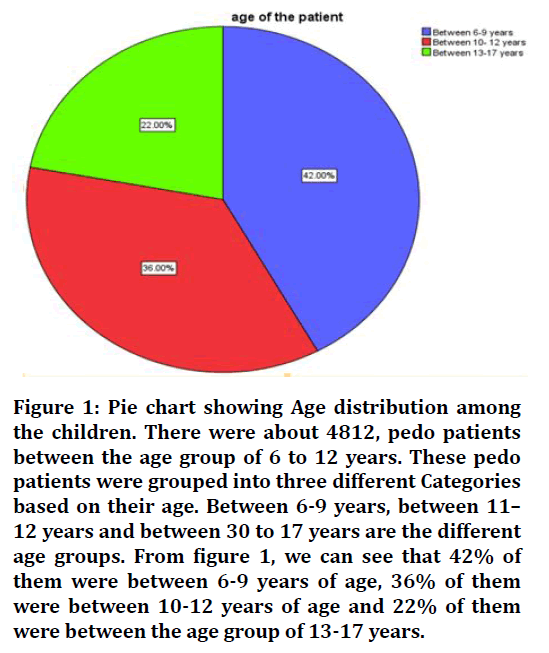
Figure 1. Pie chart showing Age distribution among the children. There were about 4812, pedo patients between the age group of 6 to 12 years. These pedo patients were grouped into three different Categories based on their age. Between 6-9 years, between 11– 12 years and between 30 to 17 years are the different age groups. From figure 1, we can see that 42% of them were between 6-9 years of age, 36% of them were between 10-12 years of age and 22% of them were between the age group of 13-17 years.
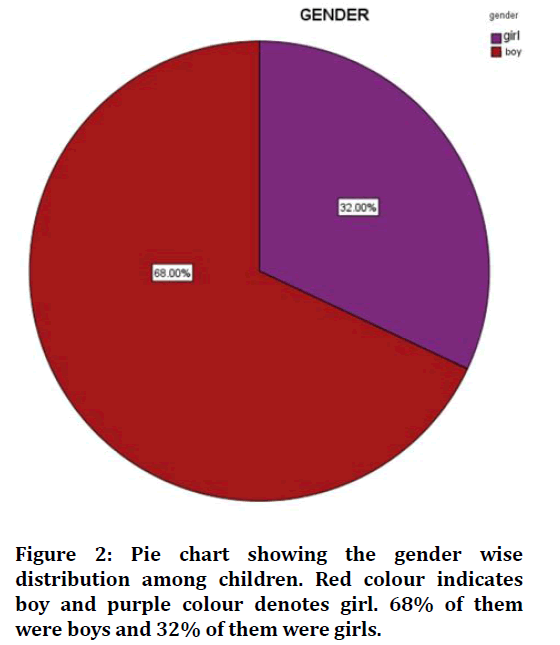
Figure 2. Pie chart showing the gender wise distribution among children. Red colour indicates boy and purple colour denotes girl. 68% of them were boys and 32% of them were girls.
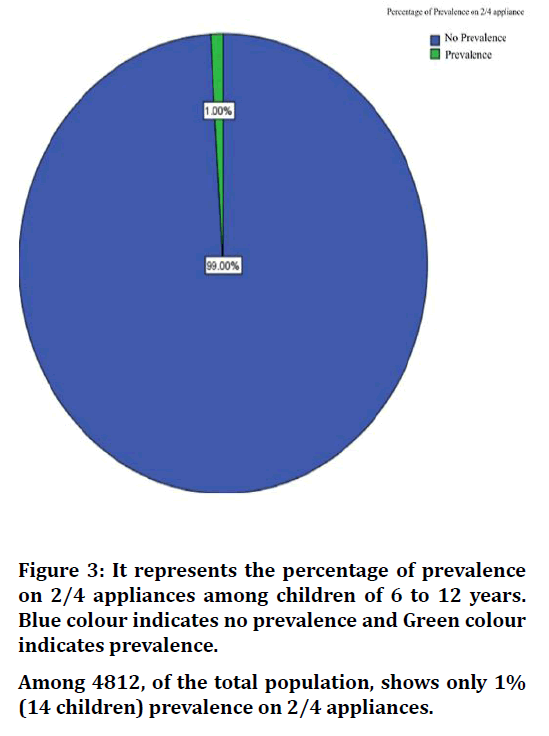
Figure 3. It represents the percentage of prevalence
on 2/4 appliances among children of 6 to 12 years.
Blue colour indicates no prevalence and Green colour
indicates prevalence.
Among 4812, of the total population, shows only 1%
(14 children) prevalence on 2/4 appliances.
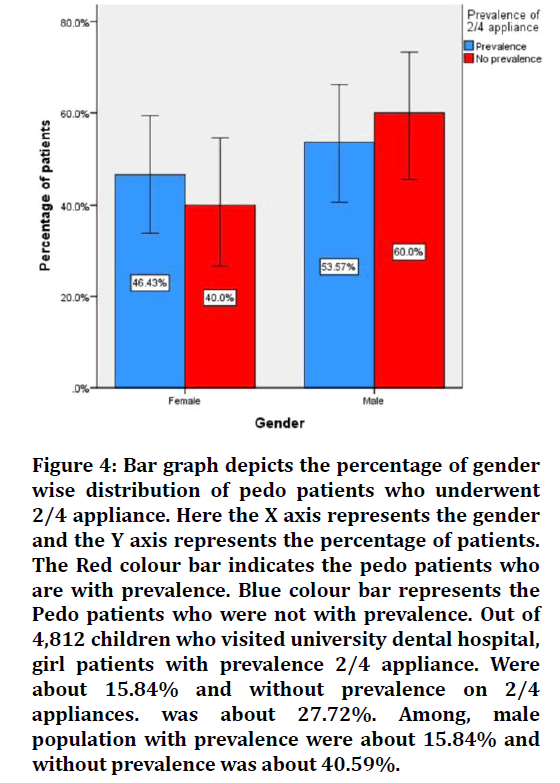
Figure 4. Bar graph depicts the percentage of gender wise distribution of pedo patients who underwent 2/4 appliance. Here the X axis represents the gender and the Y axis represents the percentage of patients. The Red colour bar indicates the pedo patients who are with prevalence. Blue colour bar represents the Pedo patients who were not with prevalence. Out of 4,812 children who visited university dental hospital, girl patients with prevalence 2/4 appliance. Were about 15.84% and without prevalence on 2/4 appliances. was about 27.72%. Among, male population with prevalence were about 15.84% and without prevalence was about 40.59%.
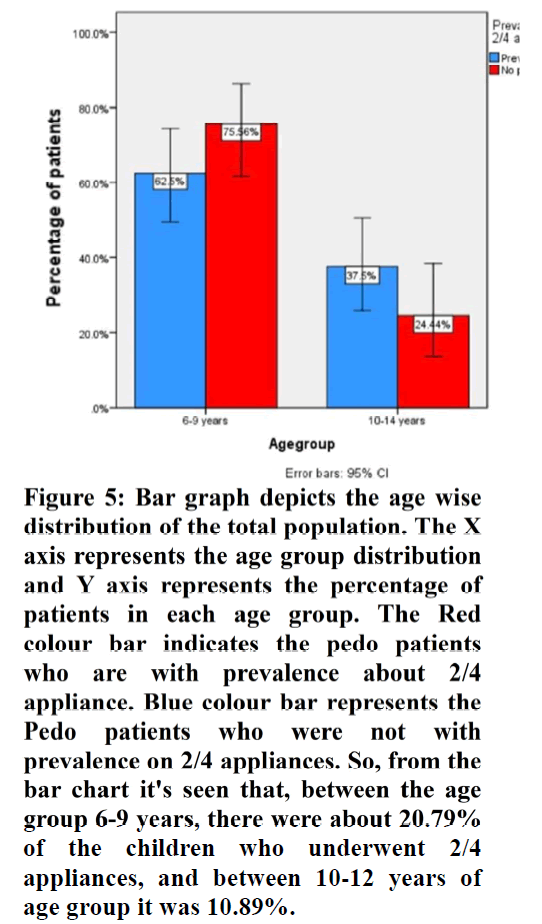
Figure 5. Bar graph depicts the age wise distribution of the total population. The X axis represents the age group distribution and Y axis represents the percentage of patients in each age group. The Red colour bar indicates the pedo patients who are with prevalence about 2/4 appliance. Blue colour bar represents the Pedo patients who were not with prevalence on 2/4 appliances. So, from the bar chart it's seen that, between the age group 6-9 years, there were about 20.79% of the children who underwent 2/4 appliances, and between 10-12 years of age group it was 10.89%.
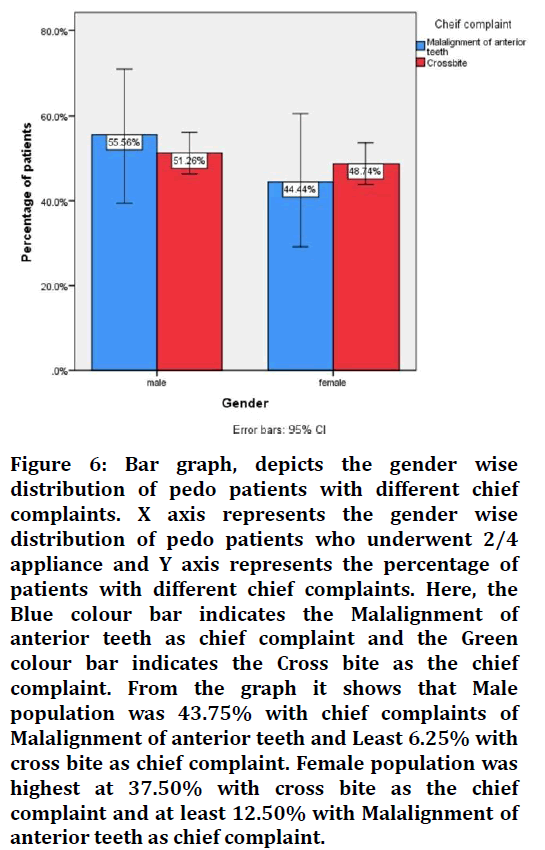
Figure 6. Bar graph, depicts the gender wise distribution of pedo patients with different chief complaints. X axis represents the gender wise distribution of pedo patients who underwent 2/4 appliance and Y axis represents the percentage of patients with different chief complaints. Here, the Blue colour bar indicates the Malalignment of anterior teeth as chief complaint and the Green colour bar indicates the Cross bite as the chief complaint. From the graph it shows that Male population was 43.75% with chief complaints of Malalignment of anterior teeth and Least 6.25% with cross bite as chief complaint. Female population was highest at 37.50% with cross bite as the chief complaint and at least 12.50% with Malalignment of anterior teeth as chief complaint.
Discussion
Related article by Sharmin et al. [39] said that sectional 2/4 fixed appliances offer an effective and efficient tooth positioning. As it allows three dimensional controls of the involved teeth during correction of misaligned anterior teeth which can be treated very quickly using such a versatile technique. In the study by Hagg et al. [40] and Reyes, et al. [41] 27 patients with pseudo-Class III were treated with the 2 x 4. After 5 years, 25 patients were examined, 20 of them did not need a second phase of treatment.
In another study by Gu et al. [42]. 17 consecutive patients (mean age 9.7 years) with pseudo-Class III malocclusion were treated with a simple fixed appliance, whereas 20 patients [mean age, 8.5 years] with skeletal Class III and anterior crossbite were treated with reverse headgear. Lateral Cephalometric radiographs taken at the beginning of treatment, end of the treatment, and 1 year after the active treatment, were analysed by modified Pancherz analysis. After active treatment the over jet correction was achieved using the 2 X 4 and reverse headgear. The over jet correction provided by the 2 x 4 appliance was due to dental changes only. These related studies prove that 2/4 appliances are very effective.
Conclusion
Within the limits of the study, it is concluded that there is low (1%) prevalence of 2/4 appliance among pediatric patients between age group 6- 12 years of age. The study shows that among 4,812 total populations only 14 of them underwent 2/4 appliances. This study is statistically significant.
References
- Watzke R, Frankenberger R, Naumann M. Different scanning electron microscopic evaluation methods of cement interface homogeneity of adhesively luted glass fiber posts. Acta Odontol Scand 2011; 69:101–107.
- Subramanyam D, Gurunathan D, Gaayathri R, et al. Comparative evaluation of salivary malondialdehyde levels as a marker of lipid peroxidation in early childhood caries. Eur J Dent 2018; 12:67-70.
- Guo-Hua P, Wang-Yuan W, Ke Q, et al. Study on rapid recognition technique of schistosome susceptibility water body I Animal skin making and effect assessment. Chinese J Schistosomiasis Control 2018; 30:200-1.
- Tan DK, Weisse C, Berent A, et al. Prospective evaluation of an indwelling esophageal balloon dilatation feeding tube for treatment of benign esophageal strictures in dogs and cats. J Vet Intern Med 2018; 32:693–700.
- Waterbury TM, Reeder GS, Pislaru SV, et al. Techniques and outcomes of paravalvular leak repair after transcatheter aortic valve replacement. Catheter Cardiovasc Interv 2017; 90:870–877.
- Zameer M, Pedodontist R. Clinical technique: Space maintenance following the premature loss of primary molars using innovative fixed unilateral space maintainers (Smart Appliances). Int J Dent Oral Sci 2020; 1172–1125.
- Dowsing P, Sandler PJ. How to effectively use a 2 × 4 appliance. J Orthodont 2004; 31:248-258.
- Jeevanandan G, Thomas E. Volumetric analysis of hand, reciprocating and rotary instrumentation techniques in primary molars using spiral computed tomography: An in vitro comparative study. Eur J Dent 2018; 21–6.
- Ericson S, Kurol J. Incisor root resorptions due to ectopic maxillary canines imaged by computerized tomography: A comparative study in extracted teeth. Angle Orthod 2000; 70:276–83.
- Ericson S, Kurol J. Resorption of maxillary lateral incisors caused by ectopic eruption of the canines: A clinical and radiographic analysis of predisposing factors. Am J Orthod Dentofac Orthop 1988; 94:503-513.
- McKeown HF, Sandler J. The two by four appliance: A versatile appliance. Dent Update 2001; 28:496–500.
- Soheilifar S, Soheilfar S, Javanshir B, et al. Recovery of clinical periodontal parameters after orthodontic appliance removal: A prospective study. Iranian J Orthod 2019; 14.
- Santhakumar P, Prathap L. Awareness on preventive measures taken by health care professionals attending COVID-19 patients among dental students. Eur J Dent 2020; 14:105-109.
- Saravanakumar K, Park S, Mariadoss AV, et al. Chemical composition, antioxidant, and anti-diabetic activities of ethyl acetate fraction of Stachys riederi var. japonica (Miq.) in streptozotocin-induced type 2 diabetic mice. Food Chem Toxicol 2021; 155:112374.
- Heidarpour M, Sadeghian S, Siadat A, et al. Comparative evaluation of a combination of facemask-removable appliance and removable appliance alone for antero-posterior expansion in 8-10-year-old Cl III children with maxillary deficiency. Iranian J Orthod 2018; 13.
- Isaacson RJ, Lindauer SJ, Rubenstein LK. Moments with the edgewise appliance: Incisor torque control. Am J Orthod Dentofac Orthop 1993; 103:428-438.
- Marchetti E, Mummolo S, Marzo G, et al. Effect of an essenzial-oil containing mouthrinse on the reduction of plaque and interproximal inflammation in comparison with an ethanol solution. Prevenzione Assistenza Dent 2009; 35:123-127.
- Huang GJ. Twin-block appliance is effective for the correction of Class II Division I malocclusion during mixed dentition. J Evid Based Dent Prac 2004; 4:222-3.
- Dorozhkin SV. Calcium orthophosphates: Applications in nature, biology, and medicine. CRC Press 2012.
- Syed MH, Gnanakkan A, Pitchiah S. Exploration of acute toxicity, analgesic, anti-inflammatory, and anti-pyretic activities of the black tunicate, Phallusia nigra (Savigny, 1816) using mice model. Env Sci Pollution Res 2021; 28:5809-21.
- Sekar D. Circular RNA: A new biomarker for different types of hypertension. Hypertension Res 2019; 42:1824-5.
- Pitcher ZP. Skeletal and dental components of Class II Division 1 correction with the MARA compared to the standard edgewise appliance. The University of Tennessee Health Science Center 2012.
- Sekar D, Johnson J, Biruntha M, et al. Biological and clinical relevance of microRNAs in mitochondrial diseases/dysfunctions. DNA Cell Biol 2020; 39:1379-84.
- Velusamy R, Sakthinathan G, Vignesh R, et al. Tribological and thermal characterization of electron beam physical vapor deposited single layer thin film for TBC application. Surface Topography Metrol Properties 2021; 9:025043.
- Aldhuwayhi S, Mallineni SK, Sakhamuri S, et al. Covid-19 knowledge and perceptions among dental specialists: A cross-sectional online questionnaire survey. Risk Manag Healthc Policy 2021; 14:2851.
- Quinzi V, Caruso S, Mummolo S, et al. Evaluation of lower dental arch crowding and dimension after treatment with lip bumper versus schwarz appliance. A prospective pilot study. Dent J 2020; 8:34.
- Wei W, Li R, Liu Q, et al. Amelioration of oxidative stress, inflammation and tumor promotion by Tin oxide-Sodium alginate-Polyethylene glycol-Allyl isothiocyanate nanocomposites on the 1, 2-Dimethylhydrazine induced colon carcinogenesis in rats. Arabian J Chem 2021; 14:103238.
- Bai L, Li J, Panagal M, et al. Methylation dependent microRNA 1285-5p and sterol carrier proteins 2 in type 2 diabetes mellitus. Artif Cells Nanomed Biotechnol 2019; 47:3417-22.
- Sekar D, Mani P, Biruntha M, et al. Dissecting the functional role of microRNA 21 in osteosarcoma. Cancer Gene Therapy 2019; 26:179-82.
- Duraisamy R, Krishnan CS, Ramasubramanian H, et al. Compatibility of nonoriginal abutments with implants: Evaluation of microgap at the implant–abutment interface, with original and nonoriginal abutments. Implant Dent 2019; 28:289-95.
- Pathak AK, Sharma DS. Biofilm associated microorganisms on removable oral orthodontic appliances in children in the mixed dentition. J Clin Pediatr Dent 2013; 37:335-340.
- Su P, Veeraraghavan VP, Krishna Mohan S, et al. A ginger derivative, zingerone—a phenolic compound—induces ROS‐mediated apoptosis in colon cancer cells (HCT‐116). J Biochem Mol Toxicol 2019; 33:e22403.
- Mathew MG, Samuel SR, Soni AJ, et al. Evaluation of adhesion of Streptococcus mutans, plaque accumulation on zirconia and stainless steel crowns, and surrounding gingival inflammation in primary molars: Randomized controlled trial. Clin Oral Investigations 2020; 24:3275-80.
- de Godoy LBM, Sousa KMM, Palombini L de O, et al. Long term oral appliance therapy decreases stress symptoms in patients with upper airway resistance syndrome. J Clin Sleep Med 2020; 16:1857–62.
- Gothandam K, Ganesan VS, Ayyasamy T, et al. Antioxidant potential of theaflavin ameliorates the activities of key enzymes of glucose metabolism in high fat diet and streptozotocin–induced diabetic rats. Redox Report 2019; 24:41-50.
- Parimelazhagan R, Umapathy D, Sivakamasundari IR, et al. Association between tumor prognosis marker visfatin and proinflammatory cytokines in hypertensive patients. Bio Med Res Int 2021; 2021.
- Ngan PW, Deguchi T, Roberts EW. Orthodontic treatment of class III malocclusion. Bentham Sci Publishers 2014; 478.
- Sekar D, Nallaswamy D, Lakshmanan G. Decoding the functional role of long noncoding RNAs (lncRNAs) in hypertension progression. Hypertension Res 2020; 43:724-5.
- Sharmin D, Sharmin VR. Management of multiple traumatic injuries in a single patient-A case report. Dent 2016; 6:1000372.
- Hägg U, Tse A, Bendeus M, et al. A follow-up study of early treatment of pseudo Class III malocclusion. Angle Orthod 2004; 74:465-472.
- Reyes A, Serret L, Peguero M, et al. Diagnosis and treatment of pseudo-Class III malocclusion. Case Reports Dent 2014; 2014.
- Gu Y, Rabie AB, Hägg U. Treatment effects of simple fixed appliance and reverse headgear in correction of anterior crossbites. Am J Orthod Dentofac Orthop 2000; 117:691-699.
Indexed at, Google Scholar, Cross Ref
Indexed at, Google Scholar, Cross Ref
Indexed at, Google Scholar, Cross Ref
Indexed at, Google Scholar, Cross Ref
Indexed at, Google Scholar, Cross Ref
Indexed at, Google Scholar, Cross Ref
Indexed at, Google Scholar, Cross Ref
Indexed at, Google Scholar, Cross Ref
Indexed at, Google Scholar, Cross Ref
Indexed at, Google Scholar, Cross Ref
Indexed at, Google Scholar, Cross Ref
Indexed at, Google Scholar, Cross Ref
Indexed at, Google Scholar, Cross Ref
Indexed at, Google Scholar, Cross Ref
Indexed at, Google Scholar, Cross Ref
Indexed at, Google Scholar, Cross Ref
Indexed at, Google Scholar, Cross Ref
Indexed at, Google Scholar, Cross Ref
Indexed at, Google Scholar, Cross Ref
Indexed at, Google Scholar, Cross Ref
Indexed at, Google Scholar, Cross Ref
Indexed at, Google Scholar, Cross Ref
Indexed at, Google Scholar, Cross Ref
Indexed at, Google Scholar, Cross Ref
Indexed at, Google Scholar, Cross Ref
Author Info
Umayal S, Geo Mani and Lavanya Govindaraju*
Department of Pediatric and Preventive Dentistry, Saveetha Institute of Medical and Technical Sciences Saveetha University, Chennai, IndiaReceived: 07-Jan-2022, Manuscript No. JRMDS-22-51337; , Pre QC No. PreQC No. JRMDS-22-51337 (PQ); Editor assigned: 10-Jan-2022, Pre QC No. PreQC No. JRMDS-22-51337 (PQ); Reviewed: 24-Jan-2022, QC No. JRMDS-22-51337; Revised: 27-Jan-2022, Manuscript No. JRMDS-22-51337 (R); Published: 03-Feb-2022
